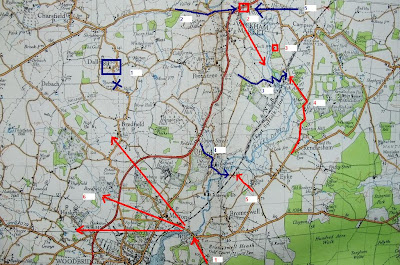Continuing on the Wilford Bridge theme after last weeks discovery, this post is about a training exercise held on Sept 9th 1940. This exercise envisaged a successful enemy sea-borne landing at Bawdsey. This was followed by an airborne landing at Sutton Walks - this airborne force (Donnerwetter Force) was to seize and hold Wilford Bridge, making good the bridgehead over the River Deben. For the purpose of this exercise, Force Donnerwetter consisted of 120 'parachute' troops, 20 bren carriers, 60 motor cyclists, 20 engineers, one vickers mg platoon and two mortars. Force Donnerwetter 'landed' at Sutton Walks at 0830 hrs and by 0930 had seized Wilford Bridge (1). Reconnaissance units were sent out to hold off the enemy until the main sea-borne force could arrive. Home Force Reconnaissance units were ambushed and destroyed at Wickam Market Bridge (2,2) and by a force at Quill Farm (3). The main British Forces were delayed by a 'fake' despatch rider who told the Home Forces that a rail crash had closed the Melton Level crossing and that the road (1) was no longer usable!
At 1145 Home Forces succeeded in crossing the Deben at Ash (3) and as a result the 'enemy' rushed up reserves from Rendlesham (4). Fierce 'fighting' resulted around Copperas Wood - the Home forces were also attacked from the rear by some carriers coming south from Wickham Market (2). By 1305, Home Forces had retaken Wickam Market Bridge from the east (5) and at 1400 also crossed the Deben at Ufford (4) and more enemy reserves were rushed up (5).
It was not until 1505 that Force Donnerwetter was overwhelmed and the Wilford Bridge secured (by which time according to the narrative the enemy had already crossed with 8 coy's of tanks which were plunging deep into Suffolk - 6).
I must admit that I did not really take much notice on training exercises from the Home Force War Diaries during my visits to The National Archives (will have to revisit) - although from memory most diaries just give the objectives of the exercise and lack the detailed feedback narratives, such as the one from Exercise Force Donnerwetter.
Coloured numbers correspond to those on the map below (red = Force Donnerwetter, blue = Home Forces).
Image 1: Map of Exercise Force Donnerwetter
Image 2: Bridge over River Deben at Ash
Image 3: Copperas Wood, with the road from Rendlesham
Image 4: Bridge over Ufford
Image 5: Possible loop-holed wall (Rendlesham) - recorded just in case I come across information in the future!





Comments
Post a Comment